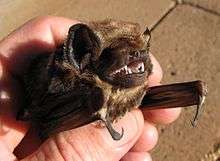Hawaiian hoary bat
| Hawaiian hoary bat | |
|---|---|
 | |
| Scientific classification | |
| Kingdom: | Animalia |
| Phylum: | Chordata |
| Class: | Mammalia |
| Order: | Chiroptera |
| Family: | Vespertilionidae |
| Genus: | Lasiurus |
| Species: | L. cinereus |
| Subspecies: | L. c. semotus |
| Trinomial name | |
| Lasiurus cinereus semotus (H.Allen, 1890) | |
The Hawaiian hoary bat or ʻōpeʻapeʻa (Lasiurus cinereus semotus) is an endangered subspecies of the hoary bat (family Vespertilionidae) that is endemic to the Hawaiian Islands. The Hawaiian hoary bat is one of two species of mammal that are endemic to the islands, the other being the Hawaiian monk seal.[2] It is a federally listed endangered taxon of the United States.
Description
The common name of the hoary bat was inspired by the hoary or "frosty" appearance of its fur, which is brown but frosted white on its back. The Hawaiian name, ʻōpeʻapeʻa ("half-leaf"), refers to the outline of the bat's body, which is shaped like half a taro leaf.[2] The Hawaiian hoary bat weighs 14 to 18 g (0.49 to 0.63 oz). The female is larger than the male, with a wingspan of approximately 10.5 to 13.5 in (27 to 34 cm). It is a nocturnal insectivore.[3] Relatively little is known about the life history of the species.
Habitat and range
The fossil record indicates that the Hawaiian hoary bat was once present on the islands of Hawaiʻi, Molokaʻi, Maui, Oʻahu, and Kauaʻi, but documented breeding populations remain only on Hawaiʻi and Kauaʻi. The complete loss of the bat from Oʻahu may have been caused by habitat loss as the human population grew in the 19th century,[4] possibly hastened by pesticide use.[5] Recordings from 2017 indicate that the bats may be present on Kahoolawe Island, long devastated by bombing and the target of habitat restoration efforts.[6]
Conservation
In 1970, the ʻōpeʻapeʻa was listed as an endangered species under the Endangered Species Conservation Act of 1969,[7] which was later replaced by the Endangered Species Act of 1973.[5][8] An "endangered species" is any species or subspecies that is "in danger of extinction throughout all or a significant portion of its range." The exact number of Hawaiian hoary bats is unknown, and the addition of the species to the list seems to have been precautionary.[9]
The United States Fish and Wildlife Service has approved a recovery plan for the Hawaiian hoary bat. The goal is to move the bat from endangered to threatened status.[5]
According to the recovery plan, populations of the bat must increase for at least five consecutive years on all islands where it is present before it can be downlisted.[5] A promising method of estimating the population is to monitor the bats' echolocation calls. Because this is the only known bat in Hawaii, any bat echolocation signals heard and recorded come from this subspecies,[10] and this monitoring method does not interfere with the animal.[11]
Surveys indicate that the bat is opportunistic and can forage over many habitat types, including native and non-native vegetation and the open ocean.[2]
References
| Wikispecies has information related to Lasiurus (Lasiurus) cinereus semotus |
- ↑ Lasiurus cinereus semotus. Environmental Conservation Online System. United States Fish and Wildlife Service.
- 1 2 3 Frasher, H. R., et al. (2007). Hawaiian hoary bat inventory in national parks on the islands of Hawaii, Maui and Molokai. Technical Report 140. Pacific Coopertive Studies Unit. University of Hawaii at Mānoa.
- ↑ Lasirus cinereus semotus. Endangered Species in the Pacific Islands. USFWS Pacific. 2012.
- ↑ Tomich, P. Q. Mammals in Hawaii (2nd edition). Honolulu, Hawaii: Bishop Museum Press. 1986.
- 1 2 3 4 Recovery Plan for the Hawaiian Hoary Bat. USFWS. May 11, 1998.
- ↑ "Hawaiian Hoary Bat Confirmed on Kaho'olawe Island - Island Conservation". Island Conservation. 2017-08-03. Retrieved 2018-01-12.
- ↑ Appendix D: United States List of Endangered Native Fish and Wildlife. Federal Register 35: 16047-48. October 13, 1970.
- ↑ Archived October 20, 2007, at the Wayback Machine.
- ↑ Fullard, J. H. (1989). `Ope`ape`a: Hawaii's elusive native bat. Bats Magazine 7(3), 10-13.
- ↑ Fenton, M. B., et al. (1994). Bats and raptors: threats and opportunities. Animal Behaviour 48(1), 9-18.
- ↑ Fullard, J. H. (1989). Echolocation survey of the distribution of the Hawaiian hoary bat (Lasiurus cinereus semotus) on the island of Kaua'i. Journal of Mammalogy 70(2), 424-26.
